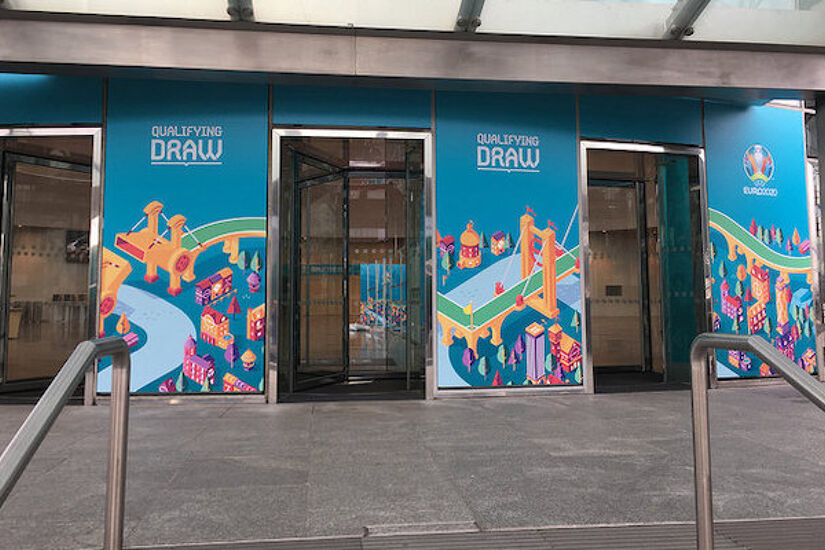EURO 2020 Dublin draw details

Credit: Macdara Ferris (ETPhotos)
Mick McCarthy may be the new manager of the Republic of Ireland but it is a member of his coaching team that is one of the special guests who will be helping with Sunday’s UEFA EURO 2020 draw in Dublin. Robbie Keane, along with Ronnie Whelan, will be Ireland’s representatives on stage.
With Portugal the reigning European champions, Nuno Gomes and Vitor Baia will also be on hand for the draw.
Having learned all the permutations and combinations about the recent UEFA Nations League, now it is time to make some space in your brain for the Euro qualifiers.
Hopefully extratime.ie has got your questions covered for what is going to happen at the Convention Centre in Dublin on Sunday lunchtime.
I’m really hoping there is an opening ceremony to the event – will I be entertained?
Don’t know about entertained but the event does kick off at 11am with a show called ‘Up & Over it’ by Suzanne Cleary and Peter Harding.
Will a famous footballer stroll onto the stage slightly awkwardly holding the competition trophy?
You are in luck as Ricardo Carvalho is in town to fulfil this role. The Champions League winner from 2004 with Porto will bring the Henri Delaunay trophy on stage.
I can’t remember which cities will be hosting the event. Will there be a reminder?
Why yes there will – a four minute video showing the dozen cities that will host EURO 2018 matches will be shown just prior to Robbie Keane, Nuno Gomez, Vitor Baia and Ronnie Whelan taking to the stage at 11:15.
After all that, my excitement may be at dangerous levels. Will I have to wait much longer for the actual draw itself?
UEFA’s running order notes that the draw will begin at 11:22.
Can you remind me how the qualification process works please?
24 teams will qualify for the finals with 20 of those positions coming through the European qualifers – the remaining four will be filled through the UEFA Nations League playoff.
No host country qualifies automatically. There will be ten qualifying groups that will be split with five groups having five teams and the remaining groups being made up with six teams in each.
Four of the five team groups will contain a team that has qualified for the UEFA Nations League finals that are scheduled for June 2019 (England, Netherlands, Portugal and Switzerland).
The top two teams in each of the ten groups will qualify automatically for EURO 2020.
So what are the seedings?
One team will be drawn from each pot as noted below although there are some complications as certain countries cannot play one another and may require a redraw.
Pot 1: England, Netherlands, Portugal and Switzerland (as UEFA Nations League playoff teams); Belgium, Croatia, France, Italy, Poland and Spain.
Pot 2: Austria, Bosnia-Herzegovina, Czech Republic, Denmark, Germany, Iceland, Russia, Sweden. Ukraine and Wales,
Pot 3: Bulgaria, Finland, Israel, Northern Ireland, Norway, Republic of Ireland,Scotland, Serbia, Slovakia and Turkey
Pot 4: Albania, Cyprus, Estonia, Georgia, Greece, Hungary, Lithuania, Montenegro, Romania and Slovenia.
Pot 5: Armenia, Azerbaijan, Belarus, Faroe Islands, Gibraltar, Kazakhstan, Kosovo, Luxembourg, Macedonia and Moldova,
Pot 6: Andorra, Latvia, Liechtenstein, Malta Sand an Marino
It all seems straight forward to me, so what do you mean by complications?
Competition-related reasons, politics, weather and geographic reasons all add some complications to the draw. Firstly a maximum of two host countries can be drawn in the same group.
Prohibited team clashes
The prohibited team clash rules mean that the following countries cannot be drawn in the same group:
Armenia / Azerbaijan
Gibraltar / Spain
Kosovo / Bosnia-Herzegovina
Kosovo / Serbia
Ukraine / Russia
No surprise to see the bottom two sides on the prohibited team clash list. Clashes in the Sea of Azov this week have raised tensions further in the Black Sea and have already affected international club football – Arsenal’s match with Vorskla Poltava on Thursday was moved to Kiev.
Winter Venue restrictions
Certain countries have been identified as venues with high or medium risk of severe winter conditions and so to minimise the risk of matches being negatively affected or even not being completed or played, a maximum of two such countries can be drawn into the same group:
Belarus, Estonia, Faroe Islands, Finland, Iceland, Latvia, Lithuania, Norway, Russia and Ukraine
Excessive travel restrictions
UEFA have also identified certain teams with excessive travel distance in relation to each other. To lessen the travel burden, a maximum of one such pair can be drawn into the same group. The following table shows the restrictions, applicable both ways:
To/From Kazakhstan with Andorra (Barcelona), England, France, Faroe Islands, Gibraltar, Iceland, Malta, Northern Ireland, Portugal, Republic of Ireland, Scotland, Spain and Wales.
It is a similar situation to and from Azerbaijan with Gibraltar, Iceland and Portugal plus to and from Iceland and Armenia, Cyprus, Georgia and Israel.
When will the qualifiers take place?
The first set of fixtures will be at the end of March 2019 with the final qualifiers set for the end of November 2019.
What games are being played and where when the tournament eventually comes around?
Final and semi-finals, one round of 16 game, three group games
London, England: Wembley Stadium
Three group games, one quarter-final
Baku, Azerbaijan: Olympic Stadium
Munich, Germany: Football Arena Munich
Rome, Italy: Stadio Olimpico
Saint Petersburg, Russia: Saint Petersburg
Three group games, one round of 16 game
Amsterdam, Netherlands: Johan Cruijff ArenA
Bilbao, Spain: San Mamés Stadium
Bucharest, Romania: National Arena
Budapest, Hungary: Puskás Ferenc Stadium
Copenhagen, Denmark: Parken Stadium
Dublin, Republic of Ireland: Dublin Arena
Glasgow, Scotland: Hampden Park
extratime.ie will be in attendance at the draw in Dublin with Dave Donnelly and Macdara Ferris getting all the post-draw reaction from the Convention Centre.
#euro2020#FridayNightLightspic.twitter.com/4oBpnJhaTl
— Macdara Ferris (@macdarabueller) November 30, 2018

